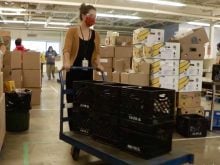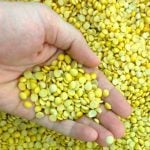The problem of food insecurity has become more complex since the COVID-19 pandemic, said Volker Kromm, executive director of the Regional Food Distribution Association, which co-ordinates the flow of food donations. Projects are underway to address it, he told those at the Dec. 11 Fields on Wheels online conference.
Why it matters: Food banks in Canada have seen heavier use in recent years.
While the pandemic introduced a new set of obstacles, it also brought unexpected opportunities regarding food security in Canada, he said, such as a surplus of food from restaurants and other sources.
Read Also

Manitoba farmers uneasy on expropriation
Farmland expropriation for Oak Bluff highway project brings process, farmer compensation concerns back to the fore.
But, “the infrastructure dollars started drying up from the federal government, and we came to realize that we have to change who we were and implement much more of a business model.”
The struggle to provide access to food is especially difficult in Canada’s north due to logistical, financial and operational challenges. First Nations communities face the steepest challenges, the highest food costs and the least access to markets, attendees were told.
Harvest Manitoba’s Harvest Voices 2024 report, which outlines food bank demand and demographics among more than 380 community organizations, found that 30 per cent of food bank clients this year were Indigenous.
Harvest Manitoba also became the first food bank to join the federal government’s Canada Nutrition North Program, which provides subsidies to help get food to remote areas. Harvest Manitoba has delivered more than 250,00 pounds of food to 10 northern First Nations last year.
Across the board, this year’s Harvest Voices survey showed an increase in the number of families using food banks, said Meaghan Erbus, director of network, advocacy and education with Harvest Manitoba.
“All of our clients are feeling the pressures of inflation, rent, low hourly wages and grocery prices,” she said in a press release Dec. 5.
Searching for support
The food distribution association has focused on finding partners, including remote communities, the mining and resource sectors, the agricultural sector and various levels of government. A shift to more fresh and healthy food has created higher logistical demands, Kromm noted. Canned and dry goods had previously been the standard due to ease of shipment.
With the shift, it needed substantial investment in infrastructure, such as freezer capacity and larger warehouses. Despite efforts, demand continued to outpace capacity.
“We were failing a large portion of the northern communities,” Kromm said, adding that many remote areas still struggle to access even basic necessities.
Over time, focus shifted to relationships with airlines and cargo centres to streamline transport. Extensive visits to communities, by air or ice roads, helped forge connections with chiefs, councils and health care professionals.
Expensive in the north
Kromm has noticed firsthand the disparity in food costs in northern and First Nations communities, noting high costs for milk, fruit and vegetables.
Addressing this required detailed inventories of accessible and inaccessible communities, calculations of the population’s needs and equitable distribution plans. It also required partnerships with Nutrition North, a federal program supporting healthy food in isolated areas, to lower costs for vulnerable populations, which comprise 20 to 35 per cent of many communities.
Once it had data, the association identified satellite hubs to serve as distribution points.
Infrastructure needed
Many challenges remain, Kromm said. Communities are far apart, and more strategic planning, relationship building and funding is necessary to expand food access to remote communities.
Many of these communities struggle with access to storage units, kitchens and educational spaces for food security and literacy. They resort to distributing food at airports and using pickup trucks to take goods to schools or health centres. While this process works, Kromm said it’s not sustainable.
“What we’re trying to do is put in the basic … configuration in all of the communities that request it,” he said.
Communities themselves would have to take ownership of the infrastructure, he added, because external organizations cannot fund such projects indefinitely.
The pilot project is a food distribution facility in Ignace, about two and a half hours outside Thunder Bay, Ont. From there, food flows to various communities.
“This is costing us at least half a million dollars … but it’s something that has to be done,” Kromm said.
For more remote communities like North Caribou Lake First Nation, 11 hours from Thunder Bay, costs are expected to be even higher.
He expects that working with mining companies and Indigenous services could be the key, as will fostering entrepreneurship.
“Without the concept of building competitiveness and entrepreneurship, I don’t think there is a way we can do this,” he said, adding that relying on food banks alone is not sustainable. Communities must become economically self-sufficient.
The organization is also looking to a project in Thunder Bay, expected to cost $6 million to $9 million, that will serve as a central hub connected to satellite hubs in other communities. That work is underway.
Excitement is growing among communities that anticipate expanded services. In one of them, local businesses, municipalities and a mining company are collaborating on a plan for food insecurity and warehousing on First Nation land.
“What started as me knocking on their doors saying, ‘hey, does your food bank need help?’ suddenly evolved into something much bigger,” Kromm said. “What’s really exciting is the development of the network. It’s all about building something that can last, and with the right partnerships, we can make it happen.”
The northern initiative is also focused on education about traditional foods and healthy alternatives from other parts of Canada.
Local food
Work in Thunder Bay has been crucial but it hasn’t been enough to satisfy the needs of the north, Kromm said. As a result, the organization is shipping food from southern Ontario, Manitoba and other parts of Canada to meet demand.
Looking ahead, Kromm is focused on deepening relationships with the agricultural industry.
“Our next step is to be able to develop partnerships with the local producers and regional producers, so that whatever configuration it is, we can provide local products, not only locally or regionally, but also to the north.”
















